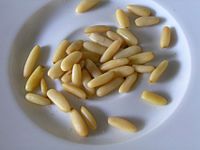Pine nut facts for kids

Pine nuts are the tasty seeds that come from certain types of pine trees. Not all pine trees make seeds big enough to eat. Only about 20 kinds of pine trees produce seeds that are worth collecting for food.
People have been eating pine nuts for a very long time, even since the Paleolithic period. They are often added to different meals like meat, fish, salads, and vegetable dishes. You can also find them baked into bread. In Italy, these nuts are called pinoli. They are a key ingredient in the famous Italian pesto sauce.
You can also press pine nuts to get pine nut oil. This oil has a gentle, nutty taste. Some other trees, like the Araucaria trees from the Southern Hemisphere, also make large edible seeds that are similar to pine nuts.
What Pine Nuts Look Like

When pine nuts first come out of a pine cone, they have a hard outer shell. This shell can be thin or thick depending on the type of pine nut. Inside, the nut holds all its nutrition. Even though we call them "nuts" when we eat them, botanically, they are actually seeds.
You need to remove the shell before you can eat a pine nut. Unshelled pine nuts can last a long time if you keep them dry and cold. But shelled nuts, or unshelled nuts kept in warm places, can go bad quickly. They might become rancid (taste spoiled) in just a few weeks or even days if it's warm and humid. Because of this, many people freeze pine nuts to keep them fresh and tasty.
Pine nuts from Europe usually look longer and thinner than those from Asia. Asian pine nuts are often shorter and rounder, a bit like a kernel of corn. American piñon nuts are known for being large and easy to shell. In the United States, the P. edulis pine nut was very popular, especially among the Navajo people who used them for trade. Italian pine nuts (P. pinea) became popular in the US in the 1930s.
How We Use Pine Nuts in Cooking
Pine nuts have been a part of meals in Europe and Asia for thousands of years. They are often mixed into meat, fish, salads, and vegetable dishes. They are also a great addition to bread.
In Italian cooking, pine nuts are called pinoli. They are a very important part of pesto sauce. This sauce became very popular in the 1990s, which helped more people discover pine nuts. Another Italian dessert is Torta della nonna, which means "granny's cake." This is often a tart or pie filled with custard, topped with pine nuts, and sometimes dusted with icing sugar. There are also "Pignoli cookies," which are an Italian American sweet. These cookies are made from almond flour and topped with pine nuts.
In Catalonia, Spain, a sweet treat called "Panellets" is made from small marzipan balls covered with pine nuts. They are brushed with egg and lightly baked. Pine nuts are also used in the salade landaise in southwestern France. The Nevada pine nut, from the Great Basin area, has a sweet, fruity taste.
Pine nuts are also widely used in Middle Eastern cooking. You can find them in many dishes like kibbeh, sambusak, and fatayer. They are also used in desserts such as baklava.
Traditionally, pine nuts used in Europe and the Middle East come from the Pinus pinea tree. These are easy to tell apart from Asian pine nuts because they are more slender. However, Asian pine nuts are often used too, especially in cheaper foods, because they cost less. Pine nuts also contain important nutrients like thiamine (vitamin B1) and protein.
In the southwestern United States, especially New Mexico, you might find "piñón" coffee. This is a dark roast coffee with a deep, nutty flavor. Roasted and lightly salted pine nuts are often sold by the roadside in New Mexico. People buy them to make this coffee or just to enjoy as a snack.
Pine nut oil is also used to add flavor to different foods.
Images for kids
-
Korean pine (Pinus koraiensis) pine nuts – unshelled, and shell, above; shelled, below
See also
 In Spanish: Piñón para niños
In Spanish: Piñón para niños









